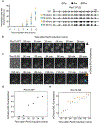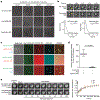Peroxisome biogenesis initiated by protein phase separation
- PMID: 37165185
- PMCID: PMC10302873
- DOI: 10.1038/s41586-023-06044-1
Peroxisome biogenesis initiated by protein phase separation
Abstract
Peroxisomes are organelles that carry out β-oxidation of fatty acids and amino acids. Both rare and prevalent diseases are caused by their dysfunction1. Among disease-causing variant genes are those required for protein transport into peroxisomes. The peroxisomal protein import machinery, which also shares similarities with chloroplasts2, is unique in transporting folded and large, up to 10 nm in diameter, protein complexes into peroxisomes3. Current models postulate a large pore formed by transmembrane proteins4; however, so far, no pore structure has been observed. In the budding yeast Saccharomyces cerevisiae, the minimum transport machinery includes the membrane proteins Pex13 and Pex14 and the cargo-protein-binding transport receptor, Pex5. Here we show that Pex13 undergoes liquid-liquid phase separation (LLPS) with Pex5-cargo. Intrinsically disordered regions in Pex13 and Pex5 resemble those found in nuclear pore complex proteins. Peroxisomal protein import depends on both the number and pattern of aromatic residues in these intrinsically disordered regions, consistent with their roles as 'stickers' in associative polymer models of LLPS5,6. Finally, imaging fluorescence cross-correlation spectroscopy shows that cargo import correlates with transient focusing of GFP-Pex13 and GFP-Pex14 on the peroxisome membrane. Pex13 and Pex14 form foci in distinct time frames, suggesting that they may form channels at different saturating concentrations of Pex5-cargo. Our findings lead us to suggest a model in which LLPS of Pex5-cargo with Pex13 and Pex14 results in transient protein transport channels7.
© 2023. The Author(s), under exclusive licence to Springer Nature Limited.
Conflict of interest statement
Figures












References
Publication types
MeSH terms
Substances
Grants and funding
LinkOut - more resources
Full Text Sources
Molecular Biology Databases

